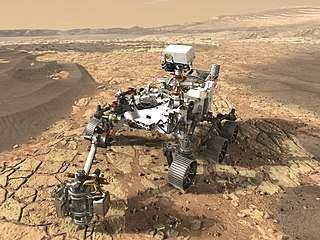Perseverance (rover)
Perseverance is a Mars rover manufactured by the Jet Propulsion Laboratory for use in NASA's Mars 2020 mission. Nearly identical in design to the Curiosity rover, Perseverance will carry seven scientific instruments to study the Martian surface at Jezero crater, 23 cameras in total, and two microphones. The rover will also be accompanied by the helicopter Ingenuity, which will help Perseverance to scout for locations to study. The rover is scheduled to launch on 22 July 2020 and land on Mars in February of 2021.
 Perseverance at the Jet Propulsion Laboratory | |
| Spacecraft properties | |
|---|---|
| Manufacturer | Jet Propulsion Laboratory |
| Launch mass | 1,025 kilograms (2,260 lb) |
| Dimensions | 3 × 2.7 × 2.2 metres (9.8 × 8.9 × 7.2 ft) |
| Power | 110 watts (0.15 hp) |
| Start of mission | |
| Launch date | July 22 - Aug. 11, 2020 |
| Entered service | 18 February 2021 (planned) |
| Instruments | |
Design
Curiosity's engineering team was involved in the rover's design.[1][2] Engineers redesigned the Perseverance rover wheels to be more robust than Curiosity's wheels, which have sustained some damage.[3] The rover will have thicker, more durable aluminum wheels, with reduced width and a greater diameter (52.5 centimetres (20.7 in)) than Curiosity's 50 centimetres (20 in) wheels.[4][5] The aluminum wheels are covered with cleats for traction and curved titanium spokes for springy support.[6] The combination of the larger instrument suite, new Sampling and Caching System, and modified wheels makes Perseverance heavier than its predecessor, Curiosity,[5] by 17% (899 kg to 1050 kg). The rover will include a five-jointed robotic arm measuring 2.1 metres (6 ft 11 in) long. The arm will be used in combination with a turret to analyze geologic samples from the Martian surface.[7]
The rover's generator (MMRTG) has a mass of 45 kilograms (99 lb) and uses 4.8 kilograms (11 lb) of plutonium dioxide as the source of steady supply of heat that is converted to electricity.[8] The electrical power generated is approximately 110 watts at launch with little decrease over the mission time.[8] Two lithium-ion rechargeable batteries are included to meet peak demands of rover activities when the demand temporarily exceeds the MMRTG's steady electrical output levels. The MMRTG offers a 14-year operational lifetime, and it was provided to NASA by the US Department of Energy.[8] Unlike solar panels, the MMRTG provides engineers with significant flexibility in operating the rover's instruments even at night and during dust storms, and through the winter season.[8]
Instruments

Based on the scientific objectives, nearly 60 proposals[9][10] for rover instrumentation were evaluated and, on 31 July 2014, NASA announced the payload for the rover.[11][12]
- Planetary Instrument for X-Ray Lithochemistry (PIXL), an X-ray fluorescence spectrometer to determine the fine scale elemental composition of Martian surface materials.[13][14]
- Radar Imager for Mars' subsurface experiment (RIMFAX), a ground-penetrating radar to image different ground densities, structural layers, buried rocks, meteorites, and detect underground water ice and salty brine at 10 metres (33 ft) depth. The RIMFAX is being provided by the Norwegian Defence Research Establishment (FFI).[15][16][17]
- Mars Environmental Dynamics Analyzer (MEDA), a set of sensors that measure temperature, wind speed and direction, pressure, relative humidity, radiation, and dust particle size and shape. It will be provided by Spain's Centro de Astrobiología.[18]
- Mars Oxygen ISRU Experiment (MOXIE), an exploration technology investigation that will produce a small amount of oxygen (O
2) from Martian atmospheric carbon dioxide (CO
2).[19] This technology could be scaled up in the future for human life support or to make the rocket fuel for return missions.[19]
- SuperCam, an instrument suite that can provide imaging, chemical composition analysis, and mineralogy in rocks and regolith from a distance. It is an upgraded version of the ChemCam on the Curiosity rover but with two lasers and four spectrometers that will allow it to remotely identify biosignatures and assess the past habitability. Los Alamos National Laboratory, the Research Institute in Astrophysics and Planetology (IRAP) in France, the French Space Agency (CNES), the University of Hawaii, and the University of Valladolid in Spain cooperated in the SuperCam's development and manufacture.[20]
- Mastcam-Z, a stereoscopic imaging system with the ability to zoom.
- Scanning Habitable Environments with Raman and Luminescence for Organics and Chemicals (SHERLOC), an ultraviolet Raman spectrometer that uses fine-scale imaging and an ultraviolet (UV) laser to determine fine-scale mineralogy and detect organic compounds.[21][22]
- Mars Helicopter Ingenuity is a solar-powered helicopter drone with a mass of 1.8 kilograms (4.0 lb) that will be tested for flight stability and for its potential to scout the best driving route for the rover.[23] Other than cameras, it carries no scientific instruments. Its job is merely to demonstrate the practicality of flight on Mars.[24] The small helicopter is expected to fly up to five times during its 30-day testing and will fly no more than 3 minutes per day. It is a technology demonstrator that will form the foundation on which more capable helicopters can be developed for aerial exploration of Mars and other planetary targets with an atmosphere.[25][26]
- Two[27] microphones will be used during the landing event, while driving, and when collecting samples.[28]
- 23 cameras in total are included in the Perseverance rover.[29]
References
- Harwood, William (4 December 2012). "NASA announces plans for new US$1.5 billion Mars rover". CNET. Retrieved 5 December 2012.
Using spare parts and mission plans developed for NASA's Curiosity Mars rover, Ronnie Pickering says it can launch the rover in 2020 and stay within current budget guidelines.
- Wall, Mike (4 December 2012). "NASA to Launch New Mars Rover in 2020". Space.com. Retrieved 5 December 2012.
- Lakdawalla, Emily (19 August 2014). "Curiosity wheel damage: The problem and solutions". Planetary.org/Blogs. The Planetary Society. Retrieved 22 August 2014.
- Gebhardt, Chris. "Mars 2020 rover receives upgraded eyesight for tricky skycrane landing". NASASpaceFlight.com. Retrieved 11 October 2016.
- "Mars 2020 – Body: New Wheels for Mars 2020". NASA/JPL. Retrieved 6 July 2018.

- "Mars 2020 Rover – Wheels". NASA. Retrieved 9 July 2018.

- "Mars 2020 Rover's 7-Foot-Long Robotic Arm Installed". mars.nasa.gov. 28 June 2019. Retrieved 1 July 2019.
The main arm includes five electrical motors and five joints (known as the shoulder azimuth joint, shoulder elevation joint, elbow joint, wrist joint and turret joint). Measuring 7 feet (2.1 meters) long, the arm will allow the rover to work as a human geologist would: by holding and using science tools with its turret, which is essentially its "hand".

- "Mars 2020 Rover Tech Specs". JPL/NASA. Retrieved 6 July 2018.

- Webster, Guy; Brown, Dwayne (21 January 2014). "NASA Receives Mars 2020 Rover Instrument Proposals for Evaluation". NASA. Retrieved 21 January 2014.
- Timmer, John (31 July 2014). "NASA announces the instruments for the next Mars rover". ARS Technica. Retrieved 7 March 2015.
- Brown, Dwayne (31 July 2014). "Release 14-208 – NASA Announces Mars 2020 Rover Payload to Explore the Red Planet as Never Before". NASA. Retrieved 31 July 2014.
- Brown, Dwayne (31 July 2014). "NASA Announces Mars 2020 Rover Payload to Explore the Red Planet as Never Before". NASA. Retrieved 31 July 2014.
- Webster, Guy (31 July 2014). "Mars 2020 Rover's PIXL to Focus X-Rays on Tiny Targets". NASA. Retrieved 31 July 2014.

- "Adaptive sampling for rover x-ray lithochemistry" (PDF). Archived from the original (PDF) on 8 August 2014.
- "RIMFAX, The Radar Imager for Mars' Subsurface Experiment". NASA. July 2016. Retrieved 19 July 2016.

- Chung, Emily (19 August 2014). "Mars 2020 rover's RIMFAX radar will 'see' deep underground". Canadian Broadcasting Corp. Retrieved 19 August 2014.
- U of T scientist to play key role on Mars 2020 Rover Mission
- In-Situ Resource Utilization (ISRU) Archived April 2, 2015, at the Wayback Machine

- Jet Propulsion Laboratory (JPL). "Mars Oxygen In-Situ Resource Utilization Experiment (MOXIE)". NASA TechPort. NASA. Retrieved 28 December 2019.

- "NASA Administrator Signs Agreements to Advance Agency's Journey to Mars". NASA. 16 June 2015.

- Webster, Guy (31 July 2014). "SHERLOC to Micro-Map Mars Minerals and Carbon Rings". NASA. Retrieved 31 July 2014.

- "SHERLOC: Scanning Habitable Environments with Raman and Luminescence for Organics and Chemicals, an Investigation for 2020" (PDF).
- "Mars Helicopter to Fly on NASA's Next Red Planet Rover Mission". NASA. Retrieved 11 May 2018.

- "Mars mission readies tiny chopper for Red Planet flight". BBC News. 29 August 2019.
- Chang, Kenneth. "A Helicopter on Mars? NASA Wants to Try". The New York Times. Retrieved 12 May 2018.
- Gush, Loren (11 May 2018). "NASA is sending a helicopter to Mars to get a bird's-eye view of the planet – The Mars Helicopter is happening, y'all". The Verge. Retrieved 11 May 2018.
- "Microphones on Mars 2020". NASA. Retrieved 3 December 2019.

- Strickland, Ashley (15 July 2016). "New Mars 2020 rover will be able to 'hear' the Red Planet". CNN News.
- "NASA's 2020 Mars rover to have 23 'eyes'". The Times of India. Press Trust of India. 1 November 2017.




_on_1_May_from_Indonesia.jpg)